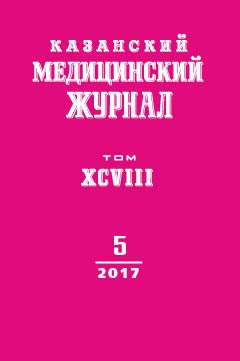The experience of minimally invasive restoration of acromioclavicular joint anatomy from mini-approach
- Authors: Kogan PG1, Chugaev DM1, Sudyakova MY.1, Lasunskiy SA1, Sorokin EP1, Stafeev DV1
-
Affiliations:
- Russian Scientific Research Institute of Traumatology and Orthopedics named after R.R. Vreden
- Issue: Vol 98, No 5 (2017)
- Pages: 851-857
- Section: Clinical experiences
- URL: https://kazanmedjournal.ru/kazanmedj/article/view/7048
- DOI: https://doi.org/10.17750/KMJ2017-851
- ID: 7048
Cite item
Full Text
Abstract
Aim. To develop a method of acromioclavicular joint stabilization with the TightRope system using «mini-open» technique and to evaluate effectiveness and safety of this surgery.
Methods. The study involved 11 patients with Rockwood type III, IV and V acromioclavicular joint dislocation, who underwent «mini-open» surgery of acromioclavicular joint stabilization using the TightRope device. The results were evaluated clinically using the Constant scale and radiologically 3, 6, and 12 months after the treatment. The results obtained were statistically processed and compared to the results of the treatment of patients with the same pathology published in the foreign literature.
Results. In the early postoperative period (up to 3 months after the surgery) functional result according to Constant scale in the studied patients varied in the score range of 67.5±16.2. In the period of up to 12 months all patients had 82.5±11.5 score, which corresponds to good and excellent results and does not show significant difference compared to the arthroscopic technique (according to literature data). Complications among observed patients occurred in 18% and were identified in 2 patients (1 case of fixation loss, 1 local skin inflammation in the area of the wound).
Conclusion. New surgical techniques allow achieving good and excellent functional results and to improve patient satisfaction.
About the authors
P G Kogan
Russian Scientific Research Institute of Traumatology and Orthopedics named after R.R. Vreden
Author for correspondence.
Email: pgkogan@rniito.ru
Saint Petersburg, Russia
D M Chugaev
Russian Scientific Research Institute of Traumatology and Orthopedics named after R.R. Vreden
Email: pgkogan@rniito.ru
Saint Petersburg, Russia
M Yu Sudyakova
Russian Scientific Research Institute of Traumatology and Orthopedics named after R.R. Vreden
Email: pgkogan@rniito.ru
Saint Petersburg, Russia
S A Lasunskiy
Russian Scientific Research Institute of Traumatology and Orthopedics named after R.R. Vreden
Email: pgkogan@rniito.ru
Saint Petersburg, Russia
E P Sorokin
Russian Scientific Research Institute of Traumatology and Orthopedics named after R.R. Vreden
Email: pgkogan@rniito.ru
Saint Petersburg, Russia
D V Stafeev
Russian Scientific Research Institute of Traumatology and Orthopedics named after R.R. Vreden
Email: pgkogan@rniito.ru
Saint Petersburg, Russia
References
- Andreani L., Bonicoli E., Parchi P. et al. Acromio-clavicular repair using two different technique. Eur. J. Orthop. Surg. Traum. 2014; 24 (2): 237-242. doi: 10.1007/s00590-013-1186-1.
- Headey J., Brooks J.H., Kemp S.P. The epidemiology of shoulder injuries in English professional rugby union. Am. J. Sports Med. 2007; 35 (9): 1537-1543. doi: 10.1177/0363546507300691.
- Bak K. Acromio-clavicular dislocation - let’s move further. Knee. Surg. Sports Traumatol. Arthrosc. 2017; 25 (7): 1987-1988. doi: 10.1007/s00167-016-4203-1.
- McKee M., Pelet S., McCormack R.G. et al. Multicenter randomized clinical trial of nonoperative versus operative treatment of acute acromio-clavicular joint dislocation. J. Orthop. Trauma. 2015; 29 (11): 479-487. doi: 10.1097/BOT.0000000000000437.
- Chen C.H., Dong Q.R., Zhou R.K. et al. Effects of hook plate on shoulder function after treatment of acromioclavicular joint dislocation. Int. J. Clin. Exp. Med. 2014; 7 (9): 2564-2570. PMID: 25356110.
- Biz C., Berizzi A., Cappellari A. et al. The treatment of acute Rockwood type III acromio-clavicular joint dislocations by two different surgical techniques. Acta Biomed. 2015; 86 (3): 251-259.
- Грицюк А.А., Середа А.П., Столяров А.А. Лечение вывиха акромиального конца ключицы с использованием методики MINAR. Астраханский мед. ж. 2012; 7 (2): 139-142.
- Gogna P., Mukhopadhyay R., Singh A. et al. Mini incision acromio-clavicular joint reconstruction using palmaris longus tendon graft. Musculoskelet Surg. 2015; 99 (1): 33-37. doi: 10.1007/s12306-014-0336-x.
- Chaudhary D., Jain V., Joshi D. et al. Arthroscopic fixation for acute acromioclavicular joint disruption using the TightRope device. J. Orthop. Surg. 2015; 23 (3): 309-314. doi: 10.1177/230949901502300310.
- Yoon J.P., Lee B.J., Nam S.J. et al. Comparison of results between hook plate fixation and ligament reconstruction for acute unstable acromioclavicular joint dislocation. Clin. Orthop. Surg. 2015; 7 (1): 97-103. doi: 10.4055/cios.2015.7.1.97.
- Zhu Y.Y., Cui H.Y., Jiang P.Q., Wang J.L. Complications of treatment of acromioclavicular joint dislocation and unstable distal clavicular fracture with clavicular hook plate. Zhongguo Gu Shang. 2013; 26 (11): 927-931. PMID: 24605745.
- Nüchtern J.V., Sellenschloh K., Bishop N. et al. Biomechanical evaluation of 3 stabilization methods on acromioclavicular joint dislocations. Am. J. Sports Med. 2013; 41 (6): 1387-1394. doi: 10.1177/0363546513484892.
- Arirachakaran A., Boonard M., Piyapittayanun P. et al. Comparison of surgical outcomes between fixation with hook plate and loop suspensory fixation for acute unstable acromioclavicular joint dislocation: a systematic review and meta-analysis. Eur. J. Orthop. Surg. Traumatol. 2016; 26 (6): 565-574. doi: 10.1007/s00590-016-1797-4.
- Faggiani M., Vasario G.P., Mattei L. et al. Comparing mini-open and arthroscopic acromioclavicular joint repair: functional results and return to sport. Musculoskelet Surg. 2016; 100 (3): 187-191. doi: 10.1007/s12306-016-0411-6.
- Saier T., Plath J.E., Beitzel K. et al. Return-to-activity after anatomical reconstruction of acute high-grade acromioclavicular separation. BMC Musculoskelet Disord. 2016; 17: 145-151. doi: 10.1186/s12891-016-0989-8.
Supplementary files







